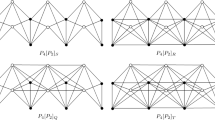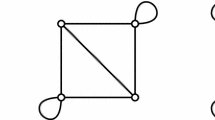Abstract
The harmonic index of a graph G is defined as the sum of the weights \(\frac{2}{\hbox{deg} _G(u)+\hbox{deg} _G(v)}\) of all edges uv of G, where \(\hbox{deg} _G(u)\) denotes the degree of a vertex u in G. In this paper, we investigate the harmonic index of Cartesian, lexicographic, tensor, strong, corona and edge corona product of two connected graphs.
Similar content being viewed by others
Avoid common mistakes on your manuscript.
Introduction
Throughout this paper, all graphs are finite, simple, undirected and connected. For a graph G, V(G) and E(G) denote the set of all vertices and edges, respectively. We will use \(P_n\), \(C_n\) and \(K_n\) to denote the path, the cycle and the complete graph of order n, respectively.
The Cartesian product \(G_1 \Box G_2\) of graphs \(G_1\) and \(G_2\) is the graph with vertex set \(V (G_1) \times V (G_2)\) in which (u, v) is adjacent to \((u', v')\) if and only if (1) \(u =u'\) and \(vv' \in E(G_2)\), or (2) \(v=v'\) and \(uu'\in E(G_1)\).
The lexicographic product (or composition) \(G_1 [ G_2]\) of graphs \(G_1\) and \(G_2\) is the graph with vertex set \(V (G_1) \times V (G_2)\) in which (u, v) is adjacent to \((u', v')\) if and only if (1) \(u u'\in E(G_1)\), or (2) \(u=u'\) and \(vv'\in E(G_2)\).
The tensor (or direct) product \(G_1 \times G_2\) of graphs \(G_1\) and \(G_2\) is the graph with vertex set \(V (G_1) \times V (G_2)\) in which (u, v) is adjacent to \((u', v')\) if and only if \(u u'\in E(G_1)\) and \(vv'\in E(G_2)\).
The strong (or normal) product \(G_1 \boxtimes G_2\) of graphs \(G_1\) and \(G_2\) is the graph with vertex set \(V (G_1) \times V (G_2)\) in which (u, v) is adjacent to \((u', v')\) if and only if (1) \(u =u'\) and \(vv' \in E(G_2)\), or (2) \(v=v'\) and \(uu'\in E(G_1)\), or (3) \(u u'\in E(G_1)\) and \(vv'\in E(G_2)\). Obviously, \(G_1 \boxtimes G_2= (G_1 \Box G_2) \cup (G_1 \times G_2)\).
Let \(V(G_1)=\{ v_1,\ldots , v_{n_1}\}\). The corona product \(G_1\circ G_2\) of disjoint graphs \(G_1\) and \(G_2\) is obtained by taking \(n_1\) copies of \(G_2\) and joining each vertex of the ith copy of \(G_2\) with the vertex \(v_i \in V (G_1)\).
Let \(E(G_1)=\{e_1,\ldots , e_{m_1}\}\). The edge corona product \(G_1\bullet G_2\) of disjoint graphs \(G_1\) and \(G_2\) is obtained by taking \(m_1\) copies of \(G_2\) and joining each vertex of the ith copy of \(G_2\) with two end vertices of the edge \(e_i \in E (G_1)\).
The following propositions easily follow from the definition and structure of product graphs.
Proposition 1.1
[8, 9] Let \(G_1\) and \(G_2\) be two graphs of orders \(n_1\) and \(n_2\), respectively. Then
-
(i)
\(\hbox{deg} _{G_1\Box G_2}(u,v) = \hbox{deg} _{G_1}(u) + \hbox{deg} _{G_2}(v)\),
-
(ii)
\(\hbox{deg} _{G_1[ G_2]}(u,v) = n_2 \hbox{deg} _{G_1}(u) + \hbox{deg} _{G_2}(v)\),
-
(iii)
\(\hbox{deg} _{G_1\times G_2}(u,v) = \hbox{deg} _{G_1}(u) \hbox{deg} _{G_2}(v)\),
-
(iv)
\(\hbox{deg} _{G_1 \boxtimes G_2}(u,v) = \hbox{deg} _{G_1}(u) + \hbox{deg} _{G_2}(v) + \hbox{deg} _{G_1}(u) \hbox{deg} _{G_2}(v)\).
Proposition 1.2
[8, 9] Let \(G_1\) and \(G_2\) be two disjoint graphs of orders \(n_1\) and \(n_2\), respectively. Then
-
(i)
\(\hbox{deg} _{G_1 \circ G_2}(u) = \left\{ \begin{array}{ll} \hbox{deg} _{G_1}(u) +n_2 &{} \quad u\in V(G_1)\\ \hbox{deg} _{G_2}(u) +1 &{} \quad u\in V(G_2), \end{array} \right.\)
-
(ii)
\(\hbox{deg} _{G_1 \bullet G_2}(u) =\left\{ \begin{array}{ll} \left( 1+n_2 \right) \hbox{deg} _{G_1}(u) &{} \quad u\in V(G_1)\\ \hbox{deg} _{G_2}(u) +2 &{} \quad u\in V(G_2). \end{array} \right.\)
The inverse degree and harmonic index of a graph G are two important vertex-degree-based indices related to G, were denoted by r(G) and H(G), respectively, and defined as follows:
In recent years, the harmonic index has been extensively studied. Shwetha et al. [9] derived expressions for the harmonic index of the join, corona product, Cartesian product, composition and symmetric difference of graphs. Recently, Onagh investigated the harmonic index of subdivision graph S(G), t-subdivision graph \(S_t(G)\), vertex-semitotal graph R(G), edge-semitotal graph Q(G), total graph T(G) and F-sum of graphs, where \(F\in \{S,S_t,R,Q,T\}\) [5–7]. More results on the harmonic index can been found in [1–3, 10–12].
In this paper, we study the harmonic index of Cartesian, lexicographic, tensor, strong, corona and edge corona product of two graphs \(G_1\) and \(G_2\) and present some bounds in terms of the harmonic index and inverse degree of \(G_1\) and \(G_2\).
Main results
In this section, we give some bounds for the harmonic index of graphs \(G_1\Box G_2\), \(G_1[ G_2]\), \(G_1\times G_2\), \(G_1 \boxtimes G_2\), \(G_1\circ G_2\) and \(G_1\bullet G_2\) in terms of \(H(G_1)\), \(H(G_2)\), \(r(G_1)\) and \(r(G_2)\). To do this, we need the following well-known inequality.
Jensen’s inequality [4] Let f be a convex function on the interval I and \(x_1, \dots ,x_n \in I\). Then
with equality if and only if \(x_1=\cdots =x_n\).
Hereafter, \(G_1\) and \(G_2\) are two nontrivial graphs with \(|V(G_i)|=n_i\) and \(|E(G_i)|=m_i\), \(1\le i\le 2\).
Theorem 2.1
Let \(G_1\) and \(G_2\) be two graphs. Then
with equality if and only if \(G_1\) and \(G_2\) are k-regular graphs.
Proof
By definition of the harmonic index, we have
By Jensen’s inequality, for every \(u\in V(G_1)\) and \(vv' \in E(G_2)\), we have
with equality if and only if \(2 \hbox{deg} _{G_1}(u) = \hbox{deg} _{G_2}(v) +\hbox{deg} _{G_2}(v')\).
Similarly, for every \(v\in V(G_2)\) and \(uu' \in E(G_1)\),
with equality if and only if \(\hbox{deg} _{G_1}(u) + \hbox{deg} _{G_1}(u') = 2 \hbox{deg} _{G_2}(v)\).
Thus,
and
So, \(H(G_1 \Box G_2) \le \frac{1}{4} \left( n_2 H(G_1) + n_1 H(G_2) + m_2 r(G_1) +m_1 r(G_2) \right)\).
Moreover, equality holds in the above inequality if and only if the inequalities (1) and (2) be equalities, i.e., \(G_1\) and \(G_2\) are k-regular. \(\square\)
Theorem 2.2
Let \(G_1\) and \(G_2\) be two graphs. Then
Proof
Note that
One can see that for every \(u\in V(G_1)\) and \(vv' \in E(G_2)\),
with equality if and only if \(2n_2 \hbox{deg} _{G_1}(u) = \hbox{deg} _{G_2}(v) +\hbox{deg} _{G_2}(v')\).□
Also, for every \(v\in V(G_2)\), \(v'\in V(G_2)\) and \(uu'\in E(G_1)\),
with equality if and only if \(n_2 ( \hbox{deg} _{G_1}(u) + \hbox{deg} _{G_1}(u') )=\hbox{deg} _{G_2}(v)= \hbox{deg} _{G_2}(v')\).
Thus,
Therefore,
Now, suppose that equality holds in the above inequality. Then, the inequalities (3) and (4) must be equalities. So, \(G_1\) and \(G_2\) are \(k_1\)-regular and \(k_2\)-regular graphs, respectively, such that \(2n_2 k_1 = k_2 + k_2\) and \(n_2 ( k_1+k_1 )=k_2\), a contradiction. \(\square\)
Theorem 2.3
Let \(G_1\) and \(G_2\) be two graphs. Then
with equality if and only if either \(G_1\) or \(G_2\) is a regular graph.
Proof
By definition of the harmonic index, we have
Note that for every \(uu'\in E(G_1)\) and \(vv'\in E(G_2)\),
with equality if and only if \(\hbox{deg} _{G_1}(u) \hbox{deg} _{G_2}(v) + \hbox{deg} _{G_1}(u') \hbox{deg} _{G_2}(v') = \hbox{deg} _{G_1}(u) \hbox{deg} _{G_2}(v') + \hbox{deg} _{G_1}(u') \hbox{deg} _{G_2}(v)\), or, equivalently, \((\hbox{deg} _{G_1}(u)- \hbox{deg} _{G_1}(u') ) (\hbox{deg} _{G_2}(v) - \hbox{deg} _{G_2}(v') )=0\). On the other hand,
and
This implies that \(H(G_1 \times G_2) \ge 2 H(G_1) H(G_2)\).□
Moreover, equality holds in the above inequality if and only if for every \(uu'\in E(G_1)\) and \(vv'\in E(G_2)\), \((\hbox{deg} _{G_1}(u)- \hbox{deg} _{G_1}(u')) (\hbox{deg} _{G_2}(v) - \hbox{deg} _{G_2}(v'))=0\), i.e., either \(G_1\) or \(G_2\) is regular. \(\square\)
The following corollary is an immediate consequence of Theorem 2.3.
Corollary 2.4
-
(i)
For any \(n\ge 3\) and \(m\ge 3\), \(H(P_n \times C_m)= \frac{4}{3}m + \frac{n-3}{2}m\),
-
(ii)
for any \(n\ge 3\) and \(m\ge 2\), \(H(P_n \times K_m)= \frac{4}{3}m + \frac{n-3}{2}m\),
-
(iii)
for any \(n\ge 3\) and \(m\ge 3\), \(H(C_n \times C_m)= \frac{nm}{2}\),
-
(iv)
for any \(n\ge 3\) and \(m\ge 2\), \(H(C_n \times K_m)=\frac{nm}{2}\),
-
(v)
for any \(n\ge 2\) and \(m\ge 2\), \(H(K_n \times K_m)= \frac{nm}{2}\).
Theorem 2.5
Let \(G_1\) and \(G_2\) be two graphs. Then
with equality if and only if \(G_1\) and \(G_2\) are 1-regular graphs.
Proof
By definition of the harmonic index, we have
Then,
By similar argument as in the proof of Theorem 2.2, one can show that
with equality if and only if \(2 \hbox{deg} _{G_1}(u) =\hbox{deg} _{G_1}(u) ( \hbox{deg} _{G_2}(v) + \hbox{deg} _{G_2}(v')) = \hbox{deg} _{G_2}(v) + \hbox{deg} _{G_2}(v')\), for all \(u\in V(G_1)\) and \(vv'\in E(G_2)\),
with equality if and only if \(\hbox{deg} _{G_1}(u) + \hbox{deg} _{G_1}(u') =\hbox{deg} _{G_2}(v)( \hbox{deg} _{G_1}(u) + \hbox{deg} _{G_1}(u') ) = 2\hbox{deg} _{G_2}(v)\), for all \(v\in V(G_2)\) and \(uu'\in E(G_1)\), and
with equality if and only if \(\hbox{deg} _{G_1}(u) + \hbox{deg} _{G_1}(u') = \ \hbox{deg} _{G_2}(v)+ \hbox{deg} _{G_2}(v') = \hbox{deg} _{G_1}(u) \hbox{deg} _{G_2}(v) + \hbox{deg} _{G_1}(u') \hbox{deg} _{G_2}(v')\), for all \(uu'\in E(G_1)\) and \(vv'\in E(G_2)\).□
Therefore,
It is easy to see that equality holds in the above inequality if and only if \(G_1\) and \(G_2\) are 1-regular graphs. \(\square\)
Theorem 2.6
Let \(G_1\) and \(G_2\) be two disjoint graphs. Then
Proof
Note that
By using a similar method, one can verify that
with equality if and only if \(\hbox{deg} _{G_1}(u) + \hbox{deg} _{G_1}(v)= 2 n_2\), for all \(uv\in E(G_1)\),
with equality if and only if \(\hbox{deg} _{G_2}(u) + \hbox{deg} _{G_2}(v)= 2\), for all \(uv\in E(G_2)\), and \(\sum 3 < \frac{2}{9}n_2 r(G_1) + \frac{2}{9}n_1 r(G_2) + \frac{2}{9} \frac{n_1n_2}{n_2+1}\).□
So,
This completes the proof. \(\square\)
Theorem 2.7
Let \(G_1\) and \(G_2\) be two disjoint graphs. Then
Proof
Note that
Similarly, one can prove that \(\sum 1 \le \frac{1}{4} m_1 H(G_2) +\frac{1}{8}m_1 m_2\), with equality if and only if \(\hbox{deg} _{G_1}(u) + \hbox{deg} _{G_1}(v)= 4\), for all \(uv\in E(G_1)\).□
Also, \(\sum 2 \le \frac{4}{9} \frac{n_1n_2}{n_2+1}+ \frac{8}{9} m_1r(G_2)+\frac{4}{9}n_2m_1\), with equality if and only if \((1+n_2)\hbox{deg} _{G_1}(u)=(1+n_2) \hbox{deg} _{G_1}(v)=\hbox{deg} _{G_2}(x)= 2\), for all \(uv\in E(G_1)\) and \(x\in V(G_2)\).
Therefore,
It is easy to show that equality cannot occur in the above inequality. \(\square\)
References
Deng, H., Balachandran, S., Ayyaswamy, S.K., Venkatakrishnan, Y.B.: On the harmonic index and the chromatic number of a graph. Discrete Appl. Math. 161, 2740–2744 (2013)
Lv, J.B., Li, J.: On the harmonic index and the matching numbers of trees. Ars Combin. 116, 407–416 (2014)
Lv, J.B., Li, J., Shiu, W.C.: The harmonic index of unicyclic graphs with given matching number. Kragujevac J. Math. 38(1), 173–182 (2014)
Niculescu, C., Persson, L.E.: Convex functions and their applications: a contemporary approach. Springer, New York (2006)
Onagh, B.N.: The harmonic index of subdivision graphs. Trans. Combin. (to appear)
Onagh, B.N.: The harmonic index for \(R\)-sum of graphs (submitted)
Onagh, B.N.: The harmonic index of edge-semitotal graphs, total graphs and related sums. Kragujevac J. Math. (to appear)
Pattabiraman, K., Nagarajan, S., Chendrasekharan, M.: Zagreb indices and coindices of product graphs. J. Prime Res. Math. 10, 80–91 (2015)
Shwetha, B.S., Lokesha, V., Ranjini, P.S.: On the harmonic index of graph operations. Trans. Combin. 4(4), 5–14 (2015)
Zhong, L.: The harmonic index for graphs. Appl. Math. Lett. 25, 561–566 (2012)
Zhong, L.: The harmonic index on unicyclic graphs. Ars Combin. 104, 261–269 (2012)
Zhong, L.: On the harmonic index and the girth for graphs. Roman. J. Inf. Sci. Technol. 16(4), 253–260 (2013)
Author information
Authors and Affiliations
Corresponding author
Rights and permissions
Open Access This article is distributed under the terms of the Creative Commons Attribution 4.0 International License (http://creativecommons.org/licenses/by/4.0/), which permits unrestricted use, distribution, and reproduction in any medium, provided you give appropriate credit to the original author(s) and the source, provide a link to the Creative Commons license, and indicate if changes were made.
About this article
Cite this article
Onagh, B.N. The harmonic index of product graphs. Math Sci 11, 203–209 (2017). https://doi.org/10.1007/s40096-017-0216-2
Received:
Accepted:
Published:
Issue Date:
DOI: https://doi.org/10.1007/s40096-017-0216-2




